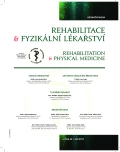Examination of the Patellofemoral Joint with Magnetic Resonance and Targeted Physiotherapy Procedures in Treatments of Retropatellar Pain
Authors:
B. Pauček 1,2; D. Smékal 2
Authors‘ workplace:
Pracoviště magnetické rezonance Medihope, DC Olomouc
vedoucí prim. MUDr. B. Pauček, Ph. D.
1; Katedra fyzioterapie, Fakulta tělesné kultury, Univerzita Palackého v Olomouci
vedoucí prof. MUDr. J. Opavský, CSc.
2
Published in:
Rehabil. fyz. Lék., 24, 2017, No. 3, pp. 131-142.
Category:
Original Papers
Overview
Aim:
To characterize and describe the morphological image of the most common causes of painful retropatellar conditions and indicate the recommended physiotherapy.
Methods:
We documented the most frequent nosological units of FP joint impairments in a group of patients examined in the Medihope magnetic resonance center of the Military Hospital in Olomouc. The patients were examined with MRI Signa HDxT 1.5 T (GE Healthcare, Milwaukee, USA) using an HD 1.5T knee coil in the standard protocol for the examination of the knee joint, with a special emphasis on axial and sagittal sequence to display the patellofemoral joint. In this review, the authors present MR findings of the most common causes of painful conditions of the ventral compartment of the knee joint, which are dysplasia of the patella with incongruence of the articular surfaces of the patellofemoral joint, symptoms of primary or secondary arthritis, a complex of changes in the chondromalacia patellae and functional changes in the lateral patella compression syndrome.
Conclusion:
The cause of retro patellar pain of the knee joint may be incongruence of the patellar articular surfaces of the patella and the surfaces of the femoral sulcus, chondropathy of the patellofemoral joint as a result of trauma, instability or overloading the joint. Magnetic resonance imaging is a valuable imaging method for the morphological differentiation of painful conditions of the ventral compartment of the knee. In the therapy of painful conditions of the patellofemoral joint, targeted physiotherapeutic procedures are applied. Physiotherapy has not only symptomatic effects in pain relief, but also specific effects on the muscle and joint structures, which allows the normalization of their condition.
Keywords:
dysplasia of the patella, physiotherapy, chondropathy, magnetic resonance imaging, retropatellar pain
Sources
1. ARAI, Y., NAKAGAWA, S., HIGUCHI, T., INOUE, A., HONJO, K., INOU, H., IKOMA, K., UESHIMA, K., IKEDA, T., FUJIWARA, H., KUBO, T.: Comparative analysis of medial patellofemoral ligament length change pattern in patients with patellar dislocation using open-MRI. Knee Surg Sports Traumatol Arthrosc., 78, 2015, 2, s. 1-7.
2. BRTKOVÁ, J.: Hoffovo těleso-opomíjená struktura. Ces. Radiol., 70, 2016, 3, s. 173-184.
3. DUNGL, P.: Ortopedie. Praha, Grada, 2005, s. 955-959.
4. FICAT, R. P., PHILIPPE, J., HUNGERFORD, D. S.: Chondromalacia patellae: A system of classification. Clin. Orthop. Relat. Res., 144, 1979, 4, s. 55-62.
5. GROSS, J. M., FETTO, J., ROSEN, E.: Vyšetření pohybového aparátu. Praha, Triton, 2005, s. 433-487.
6. HAYASHI, D., XU, L., GUERMAZI, A., KWOH, C. K., HANNON, M. J., JARRAYA, M., GREEN, S. M., JAKIC, J. M., MOORE, C. E., ROEMER, F. W.: Prevalence of MRI-detected mediopatellar plica in subjects with knee pain and the association with MRI-detected patellofemoral cartilage damage and bone marrow lesions. Musculoskelet Disord., 14, 2013, 12, s. 292.
7. KOLÁŘ, P.: Rehabilitace v klinické praxi. Praha, Galén, 2009, s. 502-503.
8. MALJANOVIČ, M., RISTIČ, V., RASOVIČ, P., MATIJEVIČ, R., MILANKOV, V.: Solitary synovial chondromatosis as a cause of Hoffa‘s fat pad impingement. Med. Pregl., 68, 2015, 2, s. 49-52.
9. PAUČEK, B.: Diagnostika syndromu Sinding-Larsen-Johansson magnetickou rezonancí. Ces. Radiol., 68, 2014, 1, s. 57-60.
10. STEFANIK, J. J., ZHU, Y., ZUMWALT, A. C., GROSS, K. D., CLAN, M., LYNCH, J. A., FREYLAW, L. A., LEWIS, C. E., ROEMER, F. W., POWERS, C. M., GUERMAZI, A., FELSON, D. T.: Association between patella alta and the prevalence and worsening of structural features of patellofemoral joint osteoarthritis: The multicenter osteoarthritis study. Arthritis Care Res., 69, 2010, 9, s. 1258-1265.
11. STOLLER, D. W.: Magnetic resonance imaging in orthopaedics and sports medicine. Baltimore, Lippincott Williams and Wilkins, 2007, s. 577-635.
Labels
Physiotherapist, university degree Rehabilitation Sports medicineArticle was published in
Rehabilitation & Physical Medicine

2017 Issue 3
- Hope Awakens with Early Diagnosis of Parkinson's Disease Based on Skin Odor
- Deep stimulation of the globus pallidus improved clinical symptoms in a patient with refractory parkinsonism and genetic mutation
Most read in this issue
- Examination of the Patellofemoral Joint with Magnetic Resonance and Targeted Physiotherapy Procedures in Treatments of Retropatellar Pain
- Constraint Induced Movement Therapy Patients after Stroke
- The Inpatient Rehabilitation after Lower Limb Amputation, Evaluation by Functional Walk Tests
- Influence of Coactivation Therapy on Stability of Children with Cerebral Palsy
